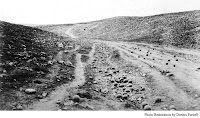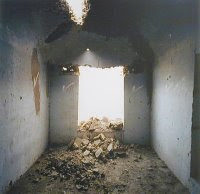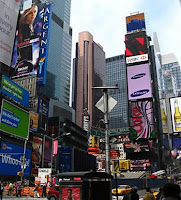Looking at the effect that war has on places and spaces. How natural beauty is destroyed by man made devices. Natural erosion to valleys and the landscape takes hundreds of years but a bomb can change the landscape in a matter of seconds. The desecration to the earth and the scars that are left behind will take hundreds of years to heal over. In the meantime we are left to wonder why.
Paul Seawright - Afghanistan
Paul Seawright was commissioned by the Imperial War Museum to visit Afghanistan during 2002 after much of the devastation had been unleashed on the country. Avoiding the trappings of an exorcising vision, best typified by the photojournalist's portrait of Afghanistan as a spectacle of ruins, his series of pictures are spare, subdued, understated and quiet.
Seawright's responses to the terrain of the destroyed and heavily mined desert landscapes of Afghanistan, both draws upon, extends and reworks the distinctive aesthetic the artist had established through earlier photographic work, made first within his home city, Belfast. In war-torn Afghanistan, Seawright is less concerned with the visible scars of war, but instead the hidden malevolence of its landscapes (www.kunstaspekte.de/index)

Seawright photographed these shell cases in Afghanistan to show the viewer the aftermath of war and to make the viewer think about what took place in this valley. Much like that of Fenton (below) the valley is littered with empy shell casings but whilst Seawright chose to show only the aftermath this was a choice that Fenton himself had not control over- he was censored by the government and therefore his images could not show actual death.
Roger Fenton, The Valley of the Shadow of Death. Crimean War

Fenton took this image during the Crimean war in 1855
The similarites in the images is obvious.. but the overall effect is the same ..the thought of what took place,the hundreds of littered bomb cases - reminiscent of skulls - this eerie silent space like that of the image above taken some hundreds of years apart serves to show us that humankind will still continue to cause desturction not only to themselves but also to the places and spaces where they live.
 Room, Afghanistan,
Room, Afghanistan,Derelict, empty, silent space
Another image by Seawright but this time showing the inside of a room that has been struck by a bomb – a place and space that was once a home – a build environment which should have been a safe haven, but now empty derelict and almost certainly hiding terrible secrets.
Columns, Afghanistan
What sort of building once stood here…again we are left with the

question what was the purpose of the construction. Large columns left as
crumbling wrecks similar to that of deteriorating and eroding ant hills, which succumb to the natural elements..except what caused this destruction was man made.




















